Artículos SCI
2020
2020
Materiales Nanoestructurados y Microestructura
Low gas consumption fabrication of He-3 solid targets for nuclear reactions
Fernandez, A; Hufschmidt, D; Colaux, JL; Valiente-Dobon, JJ; Godinho, V; de Haro, MCJ; Feria, D; Gadea, A; Lucas, SMaterials & Design, 186 (2020) 108337
Show abstract ▽
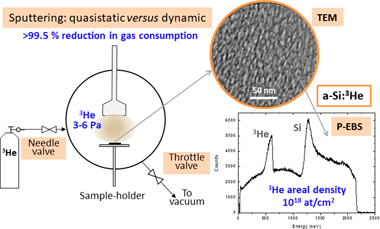
Nanoporous solids that stabilize trapped gas nanobubbles open new possibilities to fabricate solid targets for nuclear reactions. A methodology is described based on the magnetron sputtering (MS) technique operated under quasistatic flux conditions to produce such nanocomposites films with He-3 contents of up to 16 at.% in an amorphous-silicon matrix. In addition to the characteristic low pressure (3-6 Pa) needed for the gas discharge, the method ensures almost complete reduction of the process gas flow during film fabrication. The method could produce similar materials to those obtained under classical dynamic flux conditions for MS. The drastic reduction (>99.5%) of the gas consumption is fundamental for the fabrication of targets with scarce and expensive gases. Si:He-3 and W:He-3 targets are presented together with their microstructural (scanning and transmission electron microscopy, SEM and TEM respectively) and compositional (Ion Beam Analysis, IBA) characterization. The He-3 content achieved was over 1 x 10(18) at/cm(2) for film thicknesses between 1.5 and 3 mu m for both Si and W matrices. First experiments to probe the stability of the targets for nuclear reaction studies in inverse kinematics configurations are presented.
Enero, 2020 | DOI: 10.1016/j.matdes.2019.108337
Nanotecnología en Superficies y Plasma
Enhanced Stability of Perovskite Solar Cells Incorporating Dopant-Free Crystalline Spiro-OMeTAD Layers by Vacuum Sublimation
Barranco, A; Lopez-Santos, MC; Idigoras, J; Aparicio, FJ; Obrero-Perez, J; Lopez-Flores, V; Contreras-Bernal, L; Rico, V; Ferrer, J; Espinos, JP; Borras, A; Anta, JA; Sanchez-Valencia, JRAdvanced Energy Materials, (2020) 1901524
Show abstract ▽
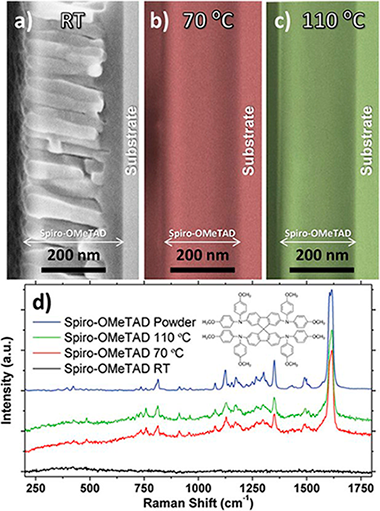
The main handicap still hindering the eventual exploitation of organometal halide perovskite-based solar cells is their poor stability under prolonged illumination, ambient conditions, and increased temperatures. This article shows for the first time the vacuum processing of the most widely used solid-state hole conductor (SSHC), i.e., the Spiro-OMeTAD [2,2 ',7,7 '-tetrakis (N,N-di-p-methoxyphenyl-amine) 9,9 '-spirobifluorene], and how its dopant-free crystalline formation unprecedently improves perovskite solar cell (PSC) stability under continuous illumination by about two orders of magnitude with respect to the solution-processed reference and after annealing in air up to 200 degrees C. It is demonstrated that the control over the temperature of the samples during the vacuum deposition enhances the crystallinity of the SSHC, obtaining a preferential orientation along the pi-pi stacking direction. These results may represent a milestone toward the full vacuum processing of hybrid organic halide PSCs as well as light-emitting diodes, with promising impacts on the development of durable devices. The microstructure, purity, and crystallinity of the vacuum sublimated Spiro-OMeTAD layers are fully elucidated by applying an unparalleled set of complementary characterization techniques, including scanning electron microscopy, X-ray diffraction, grazing-incidence small-angle X-ray scattering and grazing-incidence wide-angle X-ray scattering, X-ray photoelectron spectroscopy, and Rutherford backscattering spectroscopy.
Enero, 2020 | DOI: 10.1002/aenm.201901524
Materiales Coloidales
Bimodal Nd-Doped LuVO4 Nanoprobes Functionalized with Polyacrilic Acid for X-Ray Computed Tomography and NIR Luminescent Imaging
Nuñez, NO; Cusso, F; Cantelar, E; Martin-Gracia, B; de la Fuente, JM; Corral, A; Balcerzyk, M; Ocaña, MNanomaterials, 10 (2020) 149
Show abstract ▽
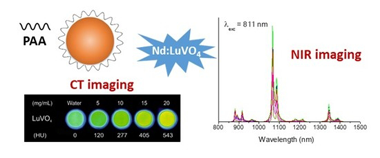
Uniform Nd3+-doped LuVO4 nanophosphors have been synthesized for the first time in literature by using a poliol-based method at 120 degrees C from Nd3+ and vanadate precursors. After optimizing the Nd doping level, these phosphors present intense luminescence in the near-infrared biological windows. The X-ray attenuation capacity of the optimum nanophosphor has been found to be higher than that of a commercial X-ray computed tomography contrast agent. After surface coating with polyacrylic acid, such nanoparticles present high colloidal stability in physiological pH medium and high cell viability. Because of these properties, the developed Nd3+-doped LuVO4 nanoparticles have potential applications as a bimodal probe for NIR luminescent bioimaging and X-ray computed tomography.
Enero, 2020 | DOI: 10.3390/nano10010149
Tribología y Protección de Superficies
Tribomechanical properties of hard Cr-doped DLC coatings deposited by low-frequency HiPIMS
Santiago, JA; Fernandez-Martinez, I; Sanchez-Lopez, JC; Rojas, TC; Wennberg, A; Bellido-Gonzalez, V; Molina-Aldareguia, JM; Monclus, MA; Gonzalez-Arrabal, RSurface & Coatings Technology, 382 (2020) 124899
Show abstract ▽
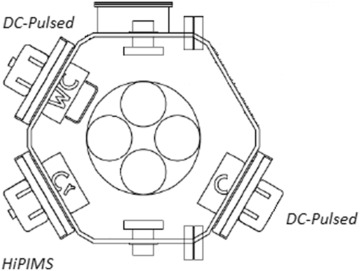
Cr-doped diamond-like carbon (Cr-DLC) films with Cr contents ranging from 3 up to 20 at. % were synthesised in a codeposition process with HiPIMS (Cr deposition) and DC-pulsed technology (C deposition). The application of HiPIMS at low frequencies was observed to significantly enhance the energy density during the Cr plasma discharge due to the interaction of Cr-C species. The higher energy bombardment at low HiPIMS frequencies allowed doping with Cr the DLC structure avoiding the graphitization of the carbon structure. EELS spectroscopy was used to evaluate sp(3) content and Raman was used for sp(2) structural characterization of the films. Enhanced mechanical properties (hardness up to 30 GPa) were observed with nanoindentation for Cr-doped DLC at low frequencies. High temperature nanoindentation tests were also performed from room temperature to 425 degrees C in order to evaluate the evolution of hardness and Young Modulus with temperature. The results showed that the mechanical properties at high temperature mainly depend on the initial sp(3)-sp(2) structure. Tribological tests were carried out in air from room temperature to 250 degrees C. Cr-doped DLC coatings deposited by low-frequency HiPIMS showed lower friction and wear compared to undoped DLC.
Enero, 2020 | DOI: 10.1016/j.surfcoat.2019.124899
Materiales Ópticos Multifuncionales
Dipole reorientation and local density of optical states influence the emission of light-emitting electrochemical cells
Jimenez-Solano, Alberto; Martinez-Sarti, Laura; Pertegas, Antonio; Lozano, Gabriel; Bolink, Henk J; Miguez, HernanPhysical Chemistry Chemical Physics, 22 (2020) 92-96
Show abstract ▽
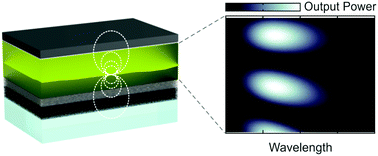
Herein, we analyze the temporal evolution of the electroluminescence of light-emitting electrochemical cells (LECs), a thin-film light-emitting device, in order to maximize the luminous power radiated by these devices. A careful analysis of the spectral and angular distribution of the emission of LECs fabricated under the same experimental conditions allows describing the dynamics of the spatial region from which LECs emit, i.e. the generation zone, as bias is applied. This effect is mediated by dipole reorientation within such an emissive region and its optical environment, since its spatial drift yields a different interplay between the intrinsic emission of the emitters and the local density of optical states of the system. Our results demonstrate that engineering the optical environment in thin-film light-emitting devices is key to maximize their brightness.
Enero, 2020 | DOI: 10.1039/c9cp05505c
- ‹ anterior
- 109 of 410
- siguiente ›














